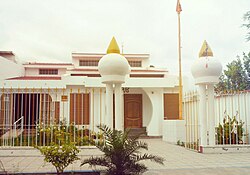 | |
 Rosario Gurdwara in Argentina. | |
| Total population | |
|---|---|
| 300 | |
| Regions with significant populations | |
| Buenos Aires · Rosario | |
| Religions | |
| Sikhism | |
| Languages | |
| Rioplatense Spanish • Punjabi • Hindi • Urdu |
Sikhs in Argentina are a religious minority in Argentina and there are estimated to be around 300 Sikhs living in the country. [1]
History
Early 20th Century
Early Immigration
Sikhs in Argentina largely settled in the early 1900s to work on the railway lines to connect to Bolivia or on the British sugar mills. Many Sikhs faced many issues in settling in Canada and USA in the early 1900s because of the anti-Asian immigration policy of United States and the Canadian whites-only policy. [2] Thus, many Sikhs were pushed to travel to Argentina in search of economic opportunities. A large number of Sikhs initially arrived in Brazil before reaching Argentina. [3]
Racism

The influx of Sikh laborers in 1912, along with Japanese and Chinese immigrants in the preceding years, triggered significant responses from Argentine politicians and immigration officials. These reactions resulted in entry restrictions, efforts to exclude them from the labour market, and diplomatic exchanges with British imperial authorities. [4]
In 1912, British Diplomat Reginald Tower wrote ‘On the subject of the immigration of Sikhs into the Argentine Republic, I have the honour to report that the Director General of Immigration, Senor Manuel Cigarraga, addressed a letter on the 21st instant to each of the foreign shipping companies represented in this Capital, urging them to refuse passages to any Asiatics to the Argentine Republic.’ [5]
Ghadar Movement
For the struggle of Indian independence from British rule, office-bearers of the Ghadar Movement had visited the Argentine Sikhs in the 1930s. [6]
Research
Sikhs in Latin America, including detailed research into Argentina, have been the subject of academic research as well. In his book "Sikhs in Latin America: Travels Among the Sikh Diaspora," Swaran Singh provides a comprehensive overview of the history and culture of Sikhs in the region. Singh's research highlights the challenges that Sikhs in Latin America face in preserving their religious and cultural traditions while also integrating into their host societies. [7]
Late 20th Century
In April 1984, President of India, Giani Zail Singh visited Argentina and gave a talk at the Argentina Congress. He met with 100 families from Punjab who emigrated to Argentina in 1930. [8]
21st Century
In 2018, the Sikh faith was officially recognised in Argentina. [9]
Many Sikhs currently own ranches, transport companies, supermarkets and retail shops in Argentina.
Simmarpal Singh is a successful Sikh Argentine businessman who is known as the 'Peanut Prince of Argentina'. In 2012, his company Olam International, had an annual revenue of Singapore $17 billion. [1]
Demographics
Most Sikhs in Argentina are Punjabi immigrants who came in 1930's or belong to the 3HO community. There has been some recent immigration from Sikhs in Punjab, India. [10] While the trend of marrying locally has been prevalent among the first and subsequent generations of Sikh immigrants, the newer immigrants display more mixed feelings on the matter. Nevertheless, a strong emotional connection to their cultural heritage persists among all of them. [11]
Gurdwara
The Sikh community in Argentina has only one Gurdwara which is based in Rosario de la Frontera. [12]
See also
References
- ^
a
b Duttagupta, Ishani (8 October 2012).
"How Simmarpal Singh helped Olam become one of the top players in peanuts in Argentina". Economic Times.
The story of the Singhs of Argentina – about 300 Sikh families who live in the northern provinces
-
^
"Sikhs in Other Latin American Countries". journeys.dartmouth.edu.
Sikhs faced many issues in settling in Canada and USA in the early 1900s because of the anti-Asian immigration policy of America and the whites-only policy of Canada. Hence many Sikhs were pushed to travel to the country they referred to as "Tina" in search of prosperity and opportunity.
-
^
"Naipaul And The Sikhs Of Argentina". Outlook India.
When groups of Sikhs did reach the shores of South America it was not always at Buenos Aires. Some had to travel further, overland through Chile or Brazil.
- ^ Bryce, Benjamin. "Undesirable Britons: South Asian Migration and the Making of a White Argentina". HAHR. Duke University. pp. 247–273. doi: 10.1215/00182168-7370225.
-
^ Singh, Khushwant (2 May 2016).
"The Argentinian Komagata Maru ought to be revealed, writes Khushwant Singh". Hindustan Times.
Tower writes: 'On the subject of the immigration of Sikhs into the Argentine Republic, I have the honour to report that the Director General of Immigration, Senor Manuel Cigarraga, addressed a letter on the 21st instant to each of the foreign shipping companies represented in this Capital, urging them to refuse passages to any Asiatics to the Argentine Republic.'
-
^
"Naipaul And The Sikhs Of Argentina". OutlookIndia. 22 February 2022.
It is known that office-bearers of the movement had visited the Argentine Sikhs in the 1930s, and had probably left some issues and other pamphlets behind.
- ^ Kahlon, Swaran (2012). Sikhs in Latin America: Travels Among the Sikh Diaspora. Manohar Publishers. ISBN 9788173049385.
- ^ "India – Argentina". Indian Consulate Argentina.
- ^ "SIKH DHARMA RECOGNIZED IN ARGENTINA IN 2018". Sikh Dharma.
-
^
"How Simmarpal Singh helped Olam become one of the top players in peanuts in Argentina". Economic Times. 8 October 2012.
The earliest immigrants came from Ludhiana to Argentina in the 1930s to work in the British sugar mills.
-
^
"Sikh Global Village – Argentina" (PDF). Sikh Global Village.
While the trend of marrying locally has been prevalent among the first and subsequent generations of immigrants, the newer immigrants display more mixed feelings on the matter. Nevertheless, a strong emotional connection to their cultural heritage persists among them
- ^ "Gurdwaras in Argentina". Gurdwaras in Argentina.